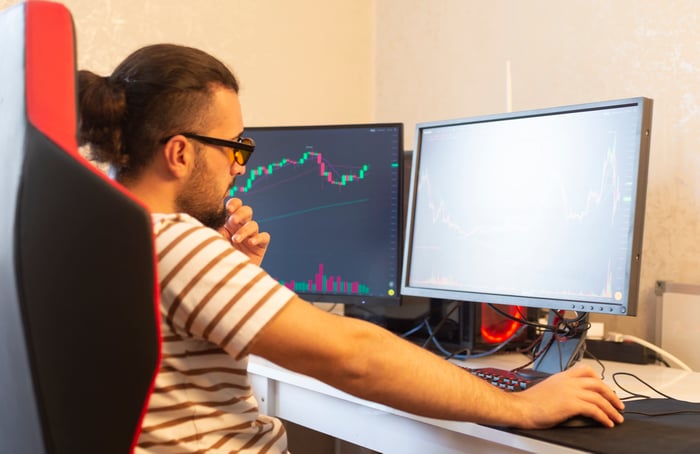The pandemic spurred a frenzy of heightened trading activity in the financial markets as wild price swings caught the interest of new investors, and stay-at-home orders afforded them the time to explore the potential opportunities.
Then, stimulus checks became the ammunition retail investors used to send certain growth stocks soaring. But many of these newcomers had short-term goals in mind and turned to riskier financial products like options contracts to juice their potential gains.
Interactive Brokers (IBKR 0.83%) is a leading online trading platform that benefited from that activity, and recent data from the company shows risk appetite among investors remains elevated. Interactive stock is attractively priced right now, and more customer engagement in the markets could result in strong long-term growth.

Image source: Getty Images.
Rapid growth follows a storied history
Interactive Brokers was founded in 1978, and it took the company until October 2020 to acquire its 1-millionth customer account. Yet, in less than two years since that date, it has crossed 1.8 million accounts (as of March 2022), which highlights how positive the pandemic was for its business.
Even though COVID-19 restrictions have eased and life is mostly back to normal, investors are still rushing to enter the financial markets.

The growth rate of new accounts might have peaked, but it still remains higher than pre-pandemic levels. What makes it more impressive is that the baseline number is much larger now, making it more difficult to pull off high growth rates. Interactive is even faring much better than its new-age competitors.
Risk appetite remains elevated
Overall trading activity on the Interactive Brokers platform is dropping from the lofty levels of early 2021, which would normally indicate investors are making fewer short-term transactions. But digging into the data tells a very different story.
|
Segment |
Q1 2021 |
Q1 2022 |
Growth (YOY) |
|---|---|---|---|
|
Options contracts |
231.8 million |
245.3 million |
6% |
|
Futures contracts |
40.9 million |
53.6 million |
31% |
|
Stocks |
308.93 billion |
97.41 billion |
(68%) |
Source: Interactive Brokers. YOY = Year over year.
Investors significantly reduced their trading volume in stocks and increased their activity in riskier financial instruments like options and futures. These are leveraged products, which means investors can increase their position size significantly by borrowing money, allowing them to boost their returns (and magnify their losses). In fact, customer margin loans grew by 14% to $48.2 billion in the recent quarter.
For further context, the first-quarter 2022 options volume figure was still three times higher than the pre-pandemic Q1 2019 number.
Buy Interactive Brokers for the long run
No matter which way it happens, more trading activity means more income for Interactive Brokers. The company's clients are holding a near-record amount of cash and assets on the platform, topping $355 billion in March, which was an 8% year-over-year increase. That figure is extremely important because the company earns fees based on transaction volume, so the more buying power clients have, the more income Interactive Brokers can potentially earn.
Interactive did see a 27% dip in revenue in Q1 2022, but that's mainly because the comparable period was almost impossible to beat, given that Q1 2021 was one of the most active periods in financial market history. Revenue did climb by 7% sequentially, though (compared to the fourth quarter of 2021).
But in the bigger picture, Interactive is an extremely profitable company making it a reliable part of any portfolio. In 2017 it generated $1.07 in earnings per share, a figure which has grown 33% compounded annually to $3.37 in 2021 -- and analysts anticipate further growth in 2022.
Interactive Brokers' stock trades at a price-to-earnings multiple of 18, which is 41% cheaper than the Nasdaq 100 technology index. That makes it a great value right now, especially for investors with a five- to 10-year time horizon.





